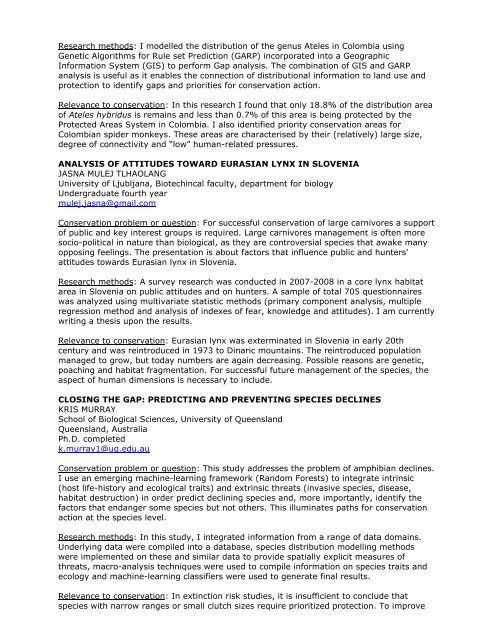Poster Abstracts in Word 29oct - American Museum of Natural History
Poster Abstracts in Word 29oct - American Museum of Natural History
Poster Abstracts in Word 29oct - American Museum of Natural History
Create successful ePaper yourself
Turn your PDF publications into a flip-book with our unique Google optimized e-Paper software.
Research methods: I modelled the distribution <strong>of</strong> the genus Ateles <strong>in</strong> Colombia us<strong>in</strong>gGenetic Algorithms for Rule set Prediction (GARP) <strong>in</strong>corporated <strong>in</strong>to a GeographicInformation System (GIS) to perform Gap analysis. The comb<strong>in</strong>ation <strong>of</strong> GIS and GARPanalysis is useful as it enables the connection <strong>of</strong> distributional <strong>in</strong>formation to land use andprotection to identify gaps and priorities for conservation action.Relevance to conservation: In this research I found that only 18.8% <strong>of</strong> the distribution area<strong>of</strong> Ateles hybridus is rema<strong>in</strong>s and less than 0.7% <strong>of</strong> this area is be<strong>in</strong>g protected by theProtected Areas System <strong>in</strong> Colombia. I also identified priority conservation areas forColombian spider monkeys. These areas are characterised by their (relatively) large size,degree <strong>of</strong> connectivity and “low” human-related pressures.ANALYSIS OF ATTITUDES TOWARD EURASIAN LYNX IN SLOVENIAJASNA MULEJ TLHAOLANGUniversity <strong>of</strong> Ljubljana, Biotech<strong>in</strong>cal faculty, department for biologyUndergraduate fourth yearmulej.jasna@gmail.comConservation problem or question: For successful conservation <strong>of</strong> large carnivores a support<strong>of</strong> public and key <strong>in</strong>terest groups is required. Large carnivores management is <strong>of</strong>ten moresocio-political <strong>in</strong> nature than biological, as they are controversial species that awake manyoppos<strong>in</strong>g feel<strong>in</strong>gs. The presentation is about factors that <strong>in</strong>fluence public and hunters'attitudes towards Eurasian lynx <strong>in</strong> Slovenia.Research methods: A survey research was conducted <strong>in</strong> 2007-2008 <strong>in</strong> a core lynx habitatarea <strong>in</strong> Slovenia on public attitudes and on hunters. A sample <strong>of</strong> total 705 questionnaireswas analyzed us<strong>in</strong>g multivariate statistic methods (primary component analysis, multipleregression method and analysis <strong>of</strong> <strong>in</strong>dexes <strong>of</strong> fear, knowledge and attitudes). I am currentlywrit<strong>in</strong>g a thesis upon the results.Relevance to conservation: Eurasian lynx was exterm<strong>in</strong>ated <strong>in</strong> Slovenia <strong>in</strong> early 20thcentury and was re<strong>in</strong>troduced <strong>in</strong> 1973 to D<strong>in</strong>aric mounta<strong>in</strong>s. The re<strong>in</strong>troduced populationmanaged to grow, but today numbers are aga<strong>in</strong> decreas<strong>in</strong>g. Possible reasons are genetic,poach<strong>in</strong>g and habitat fragmentation. For successful future management <strong>of</strong> the species, theaspect <strong>of</strong> human dimensions is necessary to <strong>in</strong>clude.CLOSING THE GAP: PREDICTING AND PREVENTING SPECIES DECLINESKRIS MURRAYSchool <strong>of</strong> Biological Sciences, University <strong>of</strong> QueenslandQueensland, AustraliaPh.D. completedk.murray1@uq.edu.auConservation problem or question: This study addresses the problem <strong>of</strong> amphibian decl<strong>in</strong>es.I use an emerg<strong>in</strong>g mach<strong>in</strong>e-learn<strong>in</strong>g framework (Random Forests) to <strong>in</strong>tegrate <strong>in</strong>tr<strong>in</strong>sic(host life-history and ecological traits) and extr<strong>in</strong>sic threats (<strong>in</strong>vasive species, disease,habitat destruction) <strong>in</strong> order predict decl<strong>in</strong><strong>in</strong>g species and, more importantly, identify thefactors that endanger some species but not others. This illum<strong>in</strong>ates paths for conservationaction at the species level.Research methods: In this study, I <strong>in</strong>tegrated <strong>in</strong>formation from a range <strong>of</strong> data doma<strong>in</strong>s.Underly<strong>in</strong>g data were compiled <strong>in</strong>to a database, species distribution modell<strong>in</strong>g methodswere implemented on these and similar data to provide spatially explicit measures <strong>of</strong>threats, macro-analysis techniques were used to compile <strong>in</strong>formation on species traits andecology and mach<strong>in</strong>e-learn<strong>in</strong>g classifiers were used to generate f<strong>in</strong>al results.Relevance to conservation: In ext<strong>in</strong>ction risk studies, it is <strong>in</strong>sufficient to conclude thatspecies with narrow ranges or small clutch sizes require prioritized protection. To improve
















